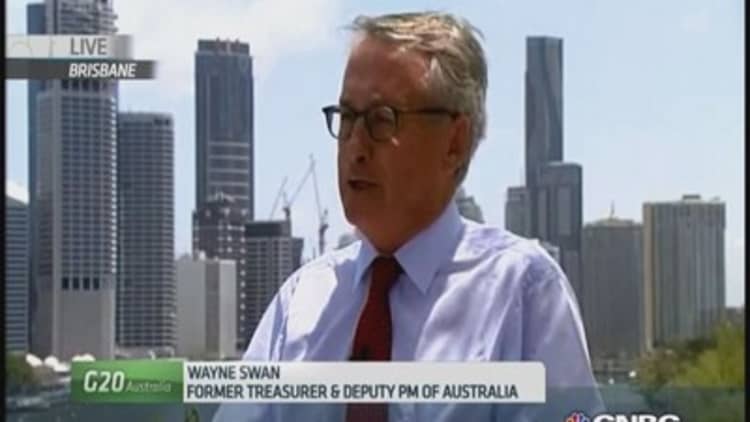Australia's economy faces myriad headwinds that could trigger interest rate cuts from the central bank, taking borrowing rates further south from current historic lows.
"Leading indicators suggest that a case can be made for further cuts: Confidence is low and consistent with weak growth, inflation expectations are falling and the unemployment rate is rising," Credit Suisse wrote in a note Friday, arguing that rates could fall to 1.5 percent.
Consumer confidence slumped over 12 percent on year in November, according to a joint survey from the Melbourne Institute and Westpac, marking the ninth straight month of pessimists outnumbering optimists - the longest slump since the global financial crisis. Meanwhile, Australia's official jobless rate rose to a 12-year high of 6.2 percent in October.
Read MoreAustralia, China to sign landmark free trade deal
Lower inflation also paves the way for rate cuts, Credit Suisse said. Headline consumer price inflation cooled to an annual 2.3 percent during the third-quarter, the lower end of the central bank's 2-3 percent target band.

Most importantly, markets have started to price in cuts, it said. The dominant view among major banks is still for the Reserve Bank of Australia to hike interest rates in 2015, but Credit Suisse says the behavior of the spread between 10-year bond yields and the cash rate is "abnormal" and doesn't reflect that view.
"The average experience of the past four tightening cycles is that the real yield curve should steepen significantly ahead of the first rate hike. Instead, it has flattened... This suggests that higher rate predictions are too aggressive and that the first rate hike could be further away than mid-2015," it said. "Alternatively, it could suggest that we are not in a tightening cycle at all, and that further easing is still possible."
Read MoreAustralia bears sharpen their claws
List of economic woes goes on
Increased angst about the recent commodity downturn could see the central bank cut rates within the next six months, Alliance Bernstein wrote in a note earlier this month. Iron ore prices are down over 40 percent so far this year, trading at five-year lows.

A decline in housing construction will also increase the probability of easing, the group said. The recent boom in the sector is widely regarded as one of the economy's bright spots and a key factor in offsetting slowing mining investment.
"Building activity is still rising, but leading indicators are leveling out. By mid-2015, the lion's share of the sector's upswing will be over. And with macro prudential measures in the cards, the housing downside could unfold more abruptly than currently expected," Alliance Bernstein said.
Read MoreAustralia to become top LNG exporter by 2018
The Australian Industry Group's closely watched gauge of construction activity eased in October, moving off September's record highs, while official data showed building approvals tumbling 11 percent on month in September, much worse than the 1 percent fall expected.
Morgan Stanley also predicts easing measures. "The last Australian recession was back in 1991. Avoiding one at this juncture requires a change in policy settings to a more stimulatory stance," the bank said in a report this month.

